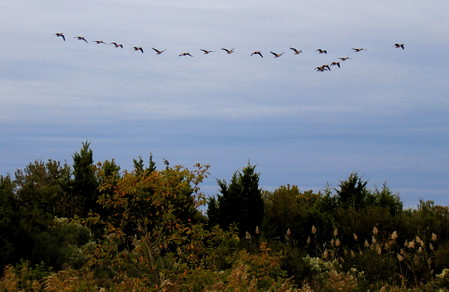I know quite a few banders and I've always wanted to try a banding project at Mr. Neil's. Number one - he's got great bird nesting habitat. Number two, a fair number of migrants pass through and use the area for fueling up for migration. So, I asked my friends Mark Newstrom and Roger Everhart who do regular banding programs at Lowry Nature Center in Carver Park if they would be interested in banding at Mr. Neil's. Being banders, the answer is generally "yes".
They were due to come Saturday morning and I had a somewhat sleepless night between my waning cold, thunder storms all night long, and just general excitement at banding. But the rains finished about 6 am followed by intense humidity.
Roger and Mark set up nets in three different areas: one near the feeders, one near a stand of pines that's full of birds, and one near a small pond. The banding conditions were not perfect. It was hot and humid (hello, it's October, it's supposed to be in the 50s in my neck of the woods), the winds were high (making it easier for birds to see the nets move), the falling leaves kept getting trapped in the nets. Above is a photo of Mark trying to get about 300 oak leaves out of the nets. They took two nets down and left one up by the feeding station.
Here is the first bird banded that day: a red-breasted nuthatch! Even though banding conditions weren't the best and with only one net, Mark and Roger managed to get band twenty-five birds (of five different species) before noon--and the feeder activity was unusually slow. Not bad!
We also got in one very feisty white-breasted nuthatch who did not care for my finger (or maybe just my green nail polish). When biting didn't seem to cause me any agony...
The nuthatch tried the clever and effective nip maneuver. Point taken, nuthatch, point taken.
At some point we had about four birds in the feeder nets at once. We would take the birds out of the nets, put them in a bag and then hang the bags on a string to await being processed. Since it was hot and humid, we had to move the bag hanging area to a more shady spot.
So, we hung them in a tree. Don't let his photo of a smiling Non Birding Bill with bags full of birds fool you. True to his identity in this blog, he showed little to no interest in the banding. He stopped out at one point and then went right back inside saying, "The excitement is too much, I need a nap."
I think the black-capped chickadees were the most common species banded that day. It seemed as soon as one got in the net and started protesting, three others would join in at the sound. Since there were so many, Mark and Roger let me band one:
Talk about pressure! I'm still learning how to do these little tiny songbirds, and I have to do it according to Roger and Mark's protocol.
They take more measurements than at Carpenter Nature Center. They do wing measurements, tail measurements, weight, and they measure individual feathers like primary wing feather 8 as well as trying to age and sex the birds. However, being just two guys, they do it quite quickly. I don't think any bird was in hand for more than five minutes.
They also blow on the body feathers to see if and where the bird is molting and to check for any fat stores the birds might have. Mark and Roger can predict when a flock of birds is about to leave an area based on their fat stores. Above is a goldfinch being blown on and if you look closely on the right of the exposed pink skin (which you can see through--that kind of grossed Lorraine out), you can see a bit of yellow--that is some fat this finch as stored up.
They ruffle the feathers on the head to see if there is any molting up there. Nice Eraserhead look. Don't worry about all the feather ruffling. One good rouse after they fly away puts all the feathers back into place.
We did have one goldfinch come in that appeared to show signs of either illness or not eating well. It was underweight to begin with and all the feathers on the head appeared appeared to have a crusty texture to them.
The bird's tail appears to be molting in late. It could be underweight with the molt or there could be something more serious going on. We're far from any rehabber and so we thought the best thing to do was let it loose and I will just stay on top of keeping the feeders clean and full of good food.
We did get one woodpecker in, this female downy woodpecker. There are usually dozens of woodpeckers at the feeders, but they were wary of the whole situation. We could hear the red-bellies calling from all corners of the yard, but none came to the feeding stations until late afternoon.
Mark and Roger showed me how dark the underside of her tail was--no doubt stained by tannins in tree bark. Woodpeckers use their stiff tails to prop themselves upright and white feathers are bound to get dirty. Based on this bird's molt pattern, Mark and Roger speculated that she was at least hatched in 2005. Pretty cool.
I was hoping we would get some of the fun birds (What am I saying! they're all fun! Let's say unusual) would come into the nets like tufted-titmice. But much like the red-bellied woodpeckers, these birds decided to avoid the feeding stations until late afternoon.
Purple finches managed to avoid the nets as well. The young of the family group are starting to show adult coloring--especially the males. More on these later.
Since it was so hot, Mark and Roger wrapped up the banding by noon--you don't want to risk birds sitting in the nets on a hot day for any extended period of time--bird safety is top priority. Later on Saturday, I was digiscoping and did find one or two of the banded birds. Here is one of the black-capped chickadees we banded. Perhaps this the one I banded? Even this morning, I saw a red-breasted nuthatch and goldfinch sporting the bands. It will be fun to watch which stick around this winter.
I'd like to thank Roger and Mark for taking the time out of their busy schedule to band birds. I hope they can come again. They are excited about the spring migration potential. Hopefully, next time it won't be 80 some degrees with high humidity.


